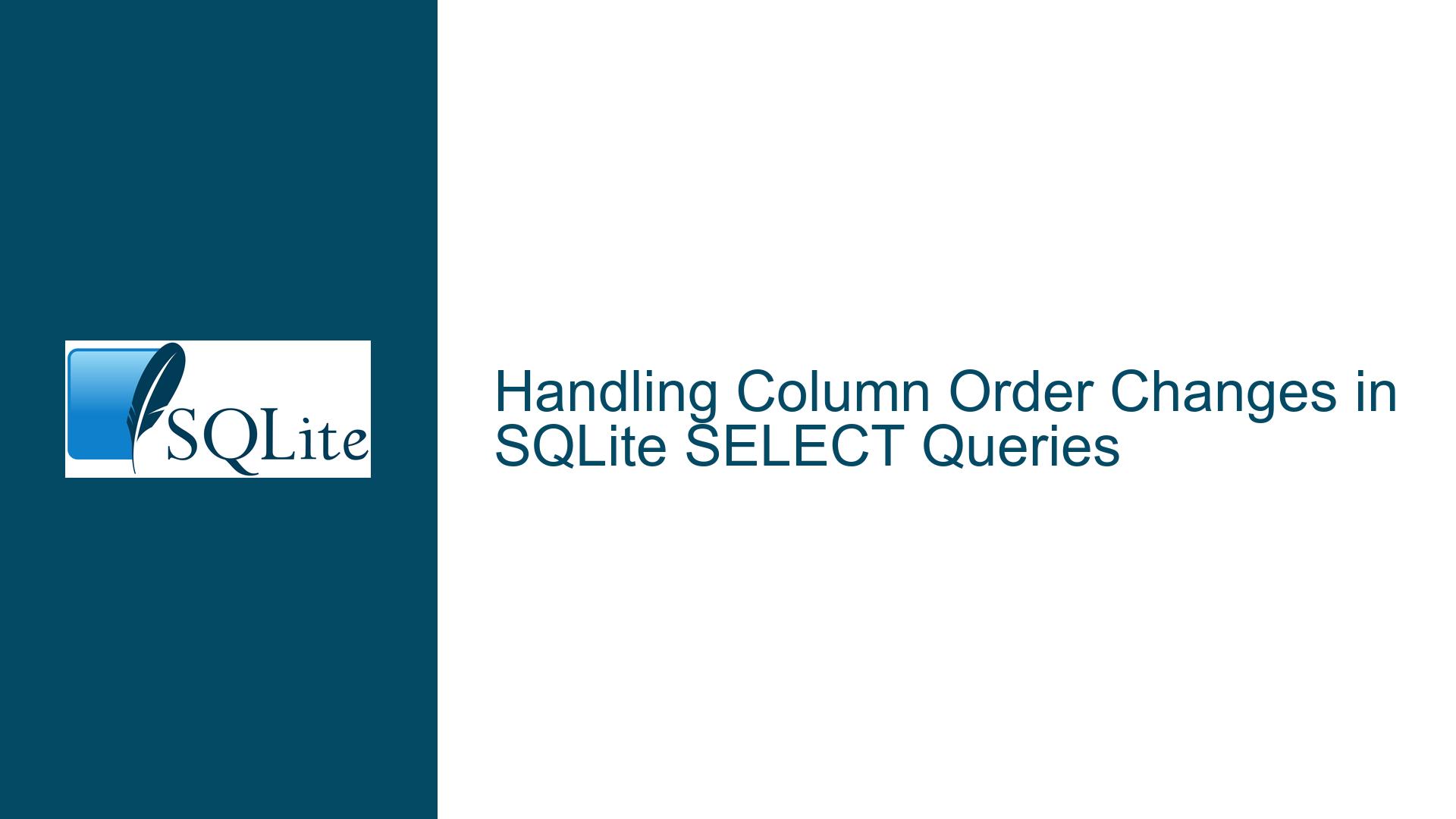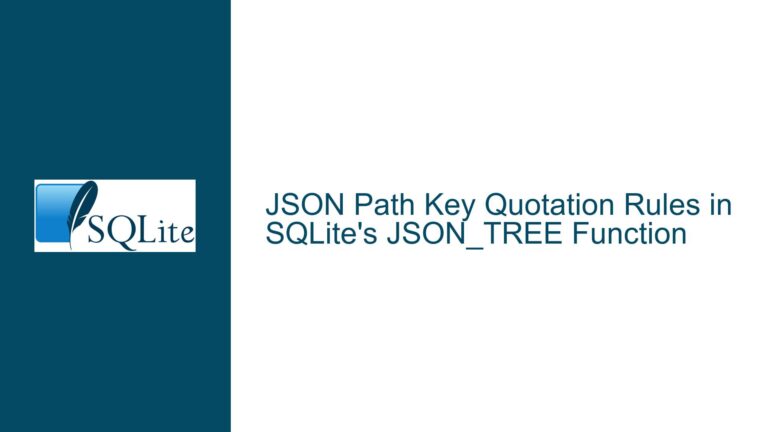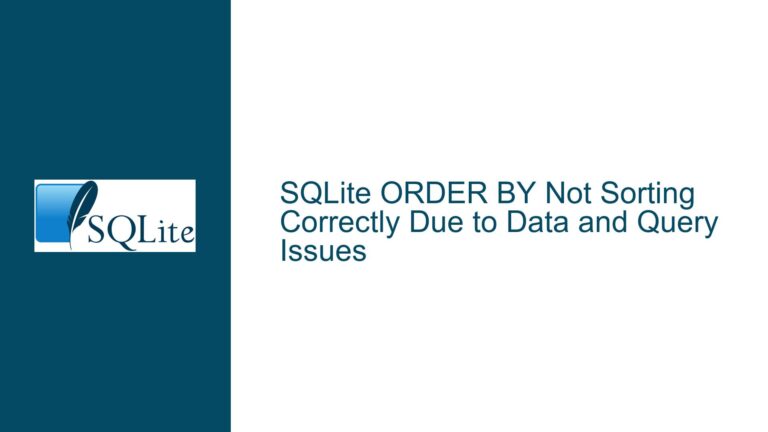Handling Column Order Changes in SQLite SELECT Queries
Issue Overview: Column Order Sensitivity in SQLite SELECT Queries
SQLite, unlike some other SQL dialects such as DB2 or Oracle, does not natively support the SELECT ... INTO ... syntax, which allows developers to map query results directly into predefined variables. This limitation becomes particularly problematic when the structure of the result set changes, such as when columns are added, removed, or reordered. In SQLite, the results of a SELECT query are accessed using zero-based column indices via the sqlite3_column... family of functions. This approach requires developers to manually track column positions, making the code brittle and prone to errors when the schema evolves.
For example, consider a table employees with columns id, name, and salary. A query like SELECT id, name, salary FROM employees would return results where id is at index 0, name at index 1, and salary at index 2. If a new column, such as department, is added between name and salary, the column indices for salary and any subsequent columns would shift. This would break existing code that relies on hardcoded column indices, requiring manual updates to reflect the new order.
The absence of a mechanism to map columns to named or user-defined indices exacerbates this issue. While some databases allow developers to specify target variables for each column in the result set, SQLite requires developers to handle this mapping programmatically. This not only increases the complexity of the code but also makes it harder to maintain and adapt to schema changes.
Possible Causes: Why Column Order Changes Break SQLite Queries
The core issue stems from SQLite’s reliance on positional indexing for accessing query results. When a SELECT query is executed, the result set is returned as a sequence of columns, each identified by a zero-based index. This design assumes that the order of columns in the result set remains consistent, which is not always the case in real-world applications. Several scenarios can lead to changes in column order:
Schema Evolution: Over time, database schemas evolve to accommodate new requirements. Columns may be added, removed, or reordered to optimize storage, improve performance, or support new features. For instance, adding a
departmentcolumn to theemployeestable would shift the indices of all subsequent columns in the result set.Dynamic Queries: In some applications, queries are constructed dynamically based on user input or application logic. If the columns included in the query change at runtime, the indices used to access the results must also be updated. This can be error-prone, especially in complex applications with many queries.
Refactoring: During code refactoring, developers may inadvertently change the order of columns in a query without updating the corresponding result-handling code. This can lead to subtle bugs that are difficult to detect and diagnose.
Third-Party Libraries: Applications that rely on third-party libraries or frameworks for database access may be affected by changes in the library’s behavior. For example, a library update might alter the way queries are constructed or results are processed, leading to unexpected changes in column order.
The lack of a built-in mechanism to handle these scenarios forces developers to implement workarounds, such as maintaining a mapping of column names to indices or using wrapper functions to abstract away the details of result processing. While these approaches can mitigate the problem, they add complexity and overhead to the codebase.
Troubleshooting Steps, Solutions & Fixes: Addressing Column Order Sensitivity in SQLite
To address the issue of column order sensitivity in SQLite, developers can adopt several strategies, ranging from best practices for schema design to advanced techniques for result processing. Below, we explore these approaches in detail, providing actionable solutions for each scenario.
1. Schema Design Best Practices
One of the most effective ways to minimize the impact of column order changes is to adopt a robust schema design strategy. This includes:
Avoiding Unnecessary Schema Changes: While schema evolution is sometimes unavoidable, developers should strive to minimize changes that affect column order. For example, instead of adding a new column in the middle of a table, consider appending it to the end. This reduces the likelihood of breaking existing queries.
Using Explicit Column Lists: When writing
SELECTqueries, always specify the columns explicitly rather than usingSELECT *. This ensures that the result set remains consistent even if the table schema changes. For example, instead ofSELECT * FROM employees, useSELECT id, name, salary FROM employees.Documenting Schema Changes: Maintain a record of all schema changes, including the rationale for each change and its potential impact on existing queries. This helps developers anticipate and address issues before they arise.
2. Programmatic Column Index Mapping
To handle column order changes programmatically, developers can implement a mapping of column names to indices. This approach involves:
Querying Column Metadata: Before processing the results of a query, use the
sqlite3_column_namefunction to retrieve the names of the columns in the result set. Store these names in a dictionary or hash map, mapping each name to its corresponding index.Accessing Columns by Name: Instead of hardcoding column indices, use the column name mapping to access the results dynamically. For example, if the
namecolumn is mapped to index 1, usesqlite3_column_text(stmt, column_map["name"])to retrieve its value.Handling Missing Columns: If a column is removed from the result set, the mapping approach allows developers to detect and handle this gracefully. For example, if the
salarycolumn is no longer present, the corresponding entry in the column map can be marked as invalid or ignored.
This approach provides a flexible and maintainable way to handle column order changes, but it requires additional code and runtime overhead.
3. Leveraging SQLite Extensions and Wrappers
For developers seeking a more streamlined solution, several SQLite extensions and third-party libraries provide support for named column access. These tools abstract away the details of column indexing, allowing developers to focus on the logic of their applications. Some popular options include:
SQLite3 API Wrappers: Libraries such as SQLAlchemy (for Python) or DBI (for Perl) provide higher-level abstractions for interacting with SQLite databases. These libraries often include built-in support for named column access, eliminating the need for manual index mapping.
Custom SQLite Extensions: Developers can create custom extensions to SQLite that implement the
SELECT ... INTO ...syntax or similar functionality. These extensions can be written in C and integrated with the SQLite core, providing a seamless experience for developers.Preprocessing Tools: Tools like
sqlite3_prepare_v2can be used to preprocess SQL statements, injecting additional logic to handle column mapping. For example, a preprocessing step could parse theSELECTstatement, extract the column names, and generate a corresponding column map.
While these solutions require additional setup and configuration, they can significantly reduce the complexity of handling column order changes in SQLite.
4. Advanced Techniques for Schema Evolution
For applications with complex schemas or frequent schema changes, advanced techniques such as versioning and migration scripts can help manage column order sensitivity. These techniques include:
Schema Versioning: Maintain a version number for the database schema, stored in a dedicated table. When the schema changes, increment the version number and update the corresponding queries to reflect the new column order.
Migration Scripts: Use automated migration scripts to apply schema changes and update queries in a controlled manner. These scripts can be integrated into the application’s deployment pipeline, ensuring that schema changes are applied consistently across all environments.
Backward Compatibility: When making schema changes, strive to maintain backward compatibility with existing queries. For example, instead of removing a column, mark it as deprecated and continue to include it in the result set until all dependent queries have been updated.
By adopting these techniques, developers can minimize the impact of schema changes on existing queries and ensure a smooth transition to new schema versions.
5. Future-Proofing SQLite Queries
To future-proof SQLite queries against column order changes, developers can adopt a proactive approach that includes:
Using Named Parameters: When constructing queries, use named parameters instead of positional parameters. This makes the query more readable and less susceptible to changes in column order.
Testing Schema Changes: Before deploying schema changes to production, thoroughly test the impact on existing queries. Use automated testing frameworks to validate that all queries continue to function as expected.
Monitoring Query Performance: Regularly monitor the performance of queries to detect any issues caused by schema changes. Use tools like
EXPLAIN QUERY PLANto analyze query execution and identify potential bottlenecks.
By following these best practices, developers can ensure that their SQLite queries remain robust and maintainable, even in the face of evolving schemas and changing requirements.
In conclusion, while SQLite’s reliance on positional indexing for query results presents challenges, these challenges can be effectively addressed through a combination of schema design best practices, programmatic column mapping, third-party tools, and advanced techniques for schema evolution. By adopting these strategies, developers can build resilient and maintainable applications that are well-equipped to handle the complexities of real-world database management.






